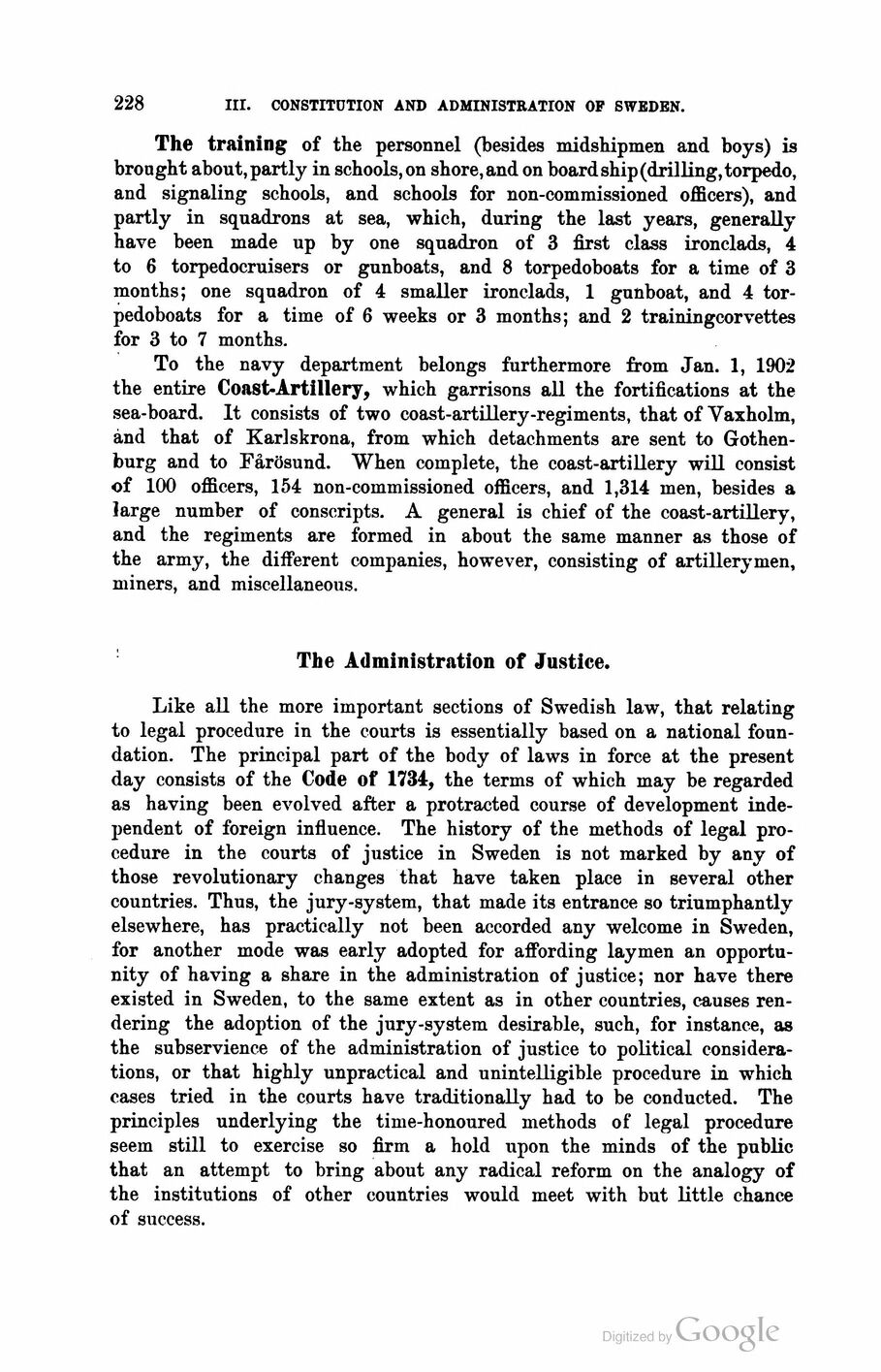
Full resolution (JPEG) - On this page / på denna sida - First part - III. Constitution and Administration - 2. State Administration - The Navy, by Commodore Capt. H. Wrangel, R. N., Stockholm - The Administration of Justice, by Hj. Hammarskjöld, L. L. D., President of the Göta Court of Appeal, Jönköping

<< prev. page << föreg. sida << >> nästa sida >> next page >>
Below is the raw OCR text
from the above scanned image.
Do you see an error? Proofread the page now!
Här nedan syns maskintolkade texten från faksimilbilden ovan.
Ser du något fel? Korrekturläs sidan nu!
This page has never been proofread. / Denna sida har aldrig korrekturlästs.
228
III. CONSTITUTION AND ADMINISTRATION OF SWEDEN.
The training of the personnel (besides midshipmen and boys) is
brought about, partly in schools, on shore, and on board ship (drilling, torpedo,
and signaling schools, and schools for non-commissioned officers), and
partly in squadrons at sea, which, during the last years, generally
have been made up by one squadron of 3 first class ironclads, 4
to 6 torpedocruisers or gunboats, and 8 torpedoboats for a time of 3
months; one squadron of 4 smaller ironclads, 1 gunboat, and 4
torpedoboats for a time of 6 weeks or 3 months; and 2 trainingcorvettes
for 3 to 7 months.
To the navy department belongs furthermore from Jan. 1, 1902
the entire Coast-Artillery, which garrisons all the fortifications at the
sea-board. It consists of two coast-artillery-regiments, that of Vaxholm,
and that of Karlskrona, from which detachments are sent to
Gothenburg and to Fårösund. When complete, the coast-artillery will consist
of 100 officers, 154 non-commissioned officers, and 1,314 men, besides a
large number of conscripts. A general is chief of the coast-artillery,
and the regiments are formed in about the same manner as those of
the army, the different companies, however, consisting of artillerymen,
miners, and miscellaneous.
The Administration of Justice,
Like all the more important sections of Swedish law, that relating
to legal procedure in the courts is essentially based on a national
foundation. The principal part of the body of laws in force at the present
day consists of the Code of 1734, the terms of which may be regarded
as having been evolved after a protracted course of development
independent of foreign influence. The history of the methods of legal
procedure in the courts of justice in Sweden is not marked by any of
those revolutionary changes that have taken place in several other
countries. Thus, the jury-system, that made its entrance so triumphantly
elsewhere, has practically not been accorded any welcome in Sweden,
for another mode was early adopted for affording laymen an
opportunity of having a share in the administration of justice; nor have there
existed in Sweden, to the same extent as in other countries, causes
rendering the adoption of the jury-system desirable, such, for instance, as
the subservience of the administration of justice to political
considerations, or that highly unpractical and unintelligible procedure in which
cases tried in the courts have traditionally had to be conducted. The
principles underlying the time-honoured methods of legal procedure
seem still to exercise so firm a hold upon the minds of the public
that an attempt to bring about any radical reform on the analogy of
the institutions of other countries would meet with but little chance
of success.
<< prev. page << föreg. sida << >> nästa sida >> next page >>